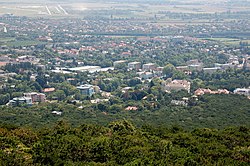Bad Vöslau
Bad Vöslau | ||
|---|---|---|
 Bad Vöslau | ||
| ||
Location of Bad Vöslau | ||
 Bad Vöslau Location within Austria | ||
| Coordinates: 47°58′N 16°13′E / 47.967°N 16.217°E / 47.967; 16.217Coordinates: 47°58′N 16°13′E / 47.967°N 16.217°E / 47.967; 16.217 | ||
| Country | Austria | |
| State | Lower Austria | |
| District | Baden | |
| Government | ||
| • Mayor | Christoph Prinz | |
| Area | ||
| • Total | 36.74 km2 (14.19 sq mi) | |
| Elevation | 276 m (906 ft) | |
| Population (1 January 2016)[1] | ||
| • Total | 11,700 | |
| • Density | 320/km2 (820/sq mi) | |
| Time zone | UTC+1 (CET) | |
| • Summer (DST) | UTC+2 (CEST) | |
| Postal code | 2540 | |
| Area code | 02252 | |
Bad Vöslau is a spa town in the Lower Austria federal state of Austria. It is also known as the cradle of the Austrian red wine cultivation. Population (2008): 11,190.
Contents
1 Geography
2 History
3 Populations
4 Personalities
5 References
6 External links
Geography
Bad Vöslau is located 35 km south of Vienna.
History
In 1770, the Earl of Fries, whose vineyards were situated around Bad Vöslau, was the first from this region to grow red wine on a large scale. The red wine and the sparkling wine from Bad Vöslau were made famous worldwide by Robert Schlumberger.
In 1954, Bad Vöslau became a city and the brand "Vöslauer Stadtsiegel" was born.
On August 26, 1867, the Treaty of Vöslau was signed between the Kingdom of Greece and the Principality of Serbia.
Populations
| Historical population | ||
|---|---|---|
| Year | Pop. | ±% |
| 1869 | 4,176 | — |
| 1880 | 5,453 | +30.6% |
| 1890 | 6,330 | +16.1% |
| 1900 | 6,987 | +10.4% |
| 1910 | 7,799 | +11.6% |
| 1923 | 8,312 | +6.6% |
| 1934 | 8,602 | +3.5% |
| 1939 | 9,848 | +14.5% |
| 1951 | 9,166 | −6.9% |
| 1961 | 9,223 | +0.6% |
| 1971 | 10,204 | +10.6% |
| 1981 | 10,524 | +3.1% |
| 1991 | 11,055 | +5.0% |
| 2001 | 10,998 | −0.5% |
| 2011 | 10,309 | −6.3% |

Vöslau castle now town hall
Personalities
Ferdinand Piatnik (1819-1885), Austrian-Hungarian carpainter, manufacturer, philanthropist, founder of Piatnik & Söhne

Johann Graf Fries (1718-1793)
Johann von Fries (1719-1785), the counts of Fries - with an interruption, from 1773 to 1902 owner of the Vöslau dominion and both historically and economically of the greatest importance for the development of the place
Ami Boué (1794-1881) came from an emigrated French Huguenot family, traveled all over Europe as a geologist and ethnologist between 1812 and 1839. He wrote about the Vöslauer sources between 1841 and 1874 nine works. He is buried in a crypt in the Vöslau cemetery.
Hannelore Valencak (1929-2004), Austrian writer, lived until her death in Bad Vöslau
Arnulf Rainer (born 1929), Austrian painter, lived and worked 1953-59 in his family-owned villa in Gainfarn, Berggasse 18
Wolfgang Gratzer (* 1965 in Bad Vöslau), musicologist and book author. 2010-2014 Vizerektor for development and research of University Mozarteum Salzburg
Jacob Levy Moreno was from 1918 to 1925 community physician and factory worker of the worsted factory. He was the founder of sociometry, group psychotherapy and "psychodrama", lived and worked in Haus Maital 4. He emigrated to the US in 1925.- Felix Auböck (*1996), Austrian 2016 Olympic swimmer
References
^ Statistik Austria - Bevölkerung zu Jahresbeginn 2002-2016 nach Gemeinden (Gebietsstand 1.1.2016) for Bad Vöslau.
External links
Town website (in German)
| Wikimedia Commons has media related to Bad Vöslau. |
| Wikivoyage has a travel guide for Bad Vöslau. |
"Municipal data for Bad Vöslau". Statistik Austria..mw-parser-output cite.citation{font-style:inherit}.mw-parser-output .citation q{quotes:"""""""'""'"}.mw-parser-output .citation .cs1-lock-free a{background:url("//upload.wikimedia.org/wikipedia/commons/thumb/6/65/Lock-green.svg/9px-Lock-green.svg.png")no-repeat;background-position:right .1em center}.mw-parser-output .citation .cs1-lock-limited a,.mw-parser-output .citation .cs1-lock-registration a{background:url("//upload.wikimedia.org/wikipedia/commons/thumb/d/d6/Lock-gray-alt-2.svg/9px-Lock-gray-alt-2.svg.png")no-repeat;background-position:right .1em center}.mw-parser-output .citation .cs1-lock-subscription a{background:url("//upload.wikimedia.org/wikipedia/commons/thumb/a/aa/Lock-red-alt-2.svg/9px-Lock-red-alt-2.svg.png")no-repeat;background-position:right .1em center}.mw-parser-output .cs1-subscription,.mw-parser-output .cs1-registration{color:#555}.mw-parser-output .cs1-subscription span,.mw-parser-output .cs1-registration span{border-bottom:1px dotted;cursor:help}.mw-parser-output .cs1-ws-icon a{background:url("//upload.wikimedia.org/wikipedia/commons/thumb/4/4c/Wikisource-logo.svg/12px-Wikisource-logo.svg.png")no-repeat;background-position:right .1em center}.mw-parser-output code.cs1-code{color:inherit;background:inherit;border:inherit;padding:inherit}.mw-parser-output .cs1-hidden-error{display:none;font-size:100%}.mw-parser-output .cs1-visible-error{font-size:100%}.mw-parser-output .cs1-maint{display:none;color:#33aa33;margin-left:0.3em}.mw-parser-output .cs1-subscription,.mw-parser-output .cs1-registration,.mw-parser-output .cs1-format{font-size:95%}.mw-parser-output .cs1-kern-left,.mw-parser-output .cs1-kern-wl-left{padding-left:0.2em}.mw-parser-output .cs1-kern-right,.mw-parser-output .cs1-kern-wl-right{padding-right:0.2em}
- Entry about Bad Vöslau in the database Gedächtnis des Landes on the history of the state of Lower Austria (Lower Austria Museum)
- Private gallery of Bad Vöslau
This Lower Austria location article is a stub. You can help Wikipedia by expanding it. |
